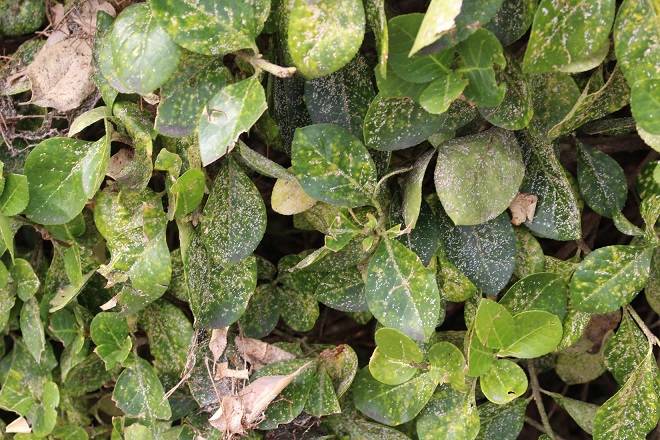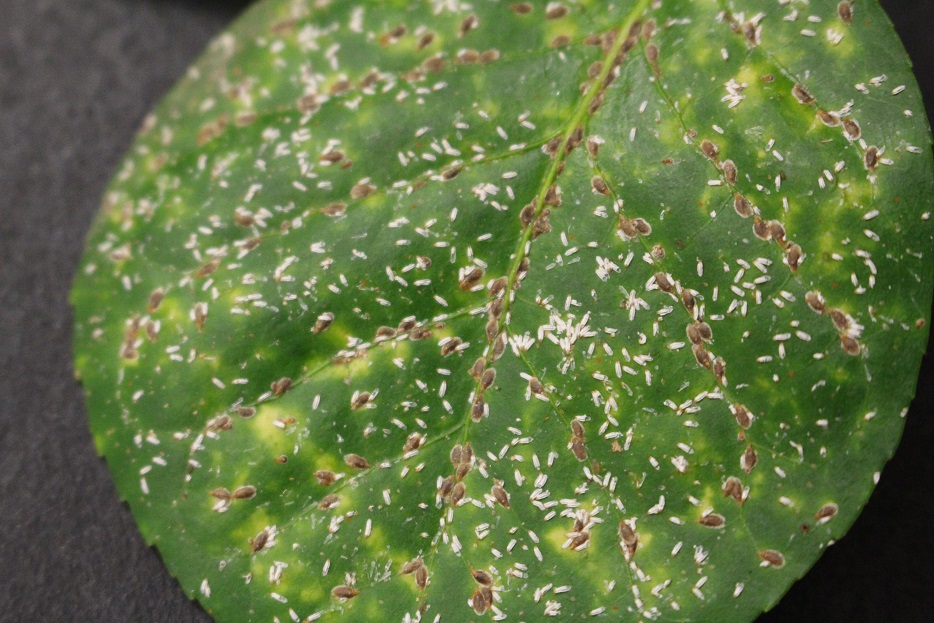–by Dr. Raymond Cloyd
We are receiving inquiries regarding euonymus scale (Unaspis euonymi) crawlers on landscape plants such as evergreen euonymus (Euonymus japonica) and Japanese pachysandra (Pachysandra terminalis). Euonymus scale overwinters as a mated female on plant stems. Eggs develop and mature underneath the scale, and then hatch over a two- to three-week period. The newly hatched crawlers, noticeable migrating along the stem, start feeding near the base of host plants. Crawlers can also infect adjacent plants by being blown around on air currents, resulting in infestations not being detected until populations are extensive and damage is noticeable later on in the season. Leaves eventually become spotted with yellow or white areas. Plants located near foundations, walls or parking areas are more susceptible to euonymus scale than plants growing in open areas that receive sunlight and air movement. Moreover, the variegated forms of euonymus are more susceptible to euonymus scale than the green forms.
Figure 1. Euonymus Shrub Heavily-Infested with EuonymusScale (Author-Raymond Cloyd, Kansas State University)
Heavy infestations of euonymus scale can ruin the aesthetic appearance of plants (Figure 1) resulting in complete defoliation or even plant death. Females are dark brown, flattened, and resemble an oystershell whereas males are elongated, ridged, and white in color (Figures 2 and 3).
Figure 2. Female and Male Euonymus Scale on Leaf (Author-Raymond Cloyd, Kansas State University)
Figure 3. Female and Male Euonymus Scale on Leaf (Author-Raymond Cloyd, Kansas State University)
Males are typically located on leaves along leaf veins and females reside on the stems. There may be up to three generations per year in Kansas.
Cultural practices such as pruning-out heavily infested branches—without ruining the aesthetic quality of the plant—is effective in quickly reducing euonymus scale populations. Be sure to immediately discard pruned branches away from the area. If feasible, avoid planting Euonymus japonica in landscapes since this species is very susceptible to euonymus scale. Winged euonymus (Euonymus alata) is less susceptible to euonymus scale, even when adjacent plants are infested. Insecticide applications conducted from May through June, when the crawlers are most active, will help alleviate problems with euonymus scale later on in the season. Insecticides recommended for suppression of euonymus scale populations include: acephate (Orthene); pyrethroid-based insecticides [bifenthrin (Talstar®), cyfluthrin (Tempo®), and lambda-cyhalothrin (Scimitar®)]; potassium salts of fatty acids (insecticidal soap); and horticultural (petroleum or mineral-based) and neem (clarified hydrophobic extract of neem oil) oil. Check plants routinely for the presence of crawlers, which will help time insecticide applications. Three to four applications, in general, should be performed at seven to 10-day intervals although this is contingent on the level of an infestation. Euonymus scale is a hard or armored scale, so, in most cases, soil or drench applications of systemic insecticides such as imidacloprid (Merit®) are not effective in suppressing euonymus scale populations. However, the systemic insecticide, dinotefuran (Safari® or Zylam®) may provide suppression of euonymus scale populations when applied as a drench to the soil due to the high water solubility (39,000 ppm) of this systemic insecticide.
Euonymus scale is susceptible to many natural enemies (e.g. parasitoids and predators) including: braconid and ichneumonid wasps, ladybird beetles, green lacewings, and minute pirate bugs. However, natural enemies may not provide enough mortality (‘killing power’) to substantially impact “high” populations of euonymus scale. Furthermore, insecticides such as acephate (Orthene®), and many of the pyrethroid-based insecticides, such as; bifenthrin (Talstar®), cyfluthrin (Tempo®), and lambda-cyhalothrin (Scimitar®) are directly harmful to natural enemies, so applications of these pesticides may disrupt any natural regulation.
I need to acknowledge Jeff Otto of Wichita, KS for informing me that euonymus scale was active in South-Central KS.


